
The Thomas Stone National Historic Site, also known as Haberdeventure or the Thomas Stone House, is a United States National Historic Site located about 25 miles (40 km) south of Washington D.C. in Charles County, Maryland. The site was established to protect the home and property of Thomas Stone, one of the 56 signers of the United States Declaration of Independence. His home and estate were owned by the Stone family until 1936.

The Seneca Historic District is a national historic district located at Poolesville, Montgomery County, Maryland. The district comprises 3,850 acres (1,560 ha) of federal, state, and county parkland and farmland in which 15 historic buildings are situated. The Chesapeake and Ohio Canal, including Seneca Aqueduct, Lock No. 24, the adjacent lock house; as well as the Seneca Quarry and quarry masters house above the quarry also stand within the district and are also within Seneca Creek State Park. The 15 historic structures are surrounded by dependencies of various periods, in most cases dating from the period of the dwelling. There are slave quarters, smokehouses, springhouses, corn cribs, and tobacco barns.

Cherry Grove, located on property formerly called Fredericksburg, is a historic home and forced-labor farm located at Woodbine, Howard County, Maryland, United States. The home is considered the seat of the Warfield family of Maryland.

Woodlawn, is a historic slave plantation located at Columbia, Howard County, Maryland. It is a two-story, stuccoed stone house built in 1840 with wood frame portions constructed about 1785. It was part of a 200-acre farm divided from larger parcels patented by the Dorsey family. The design reflects the transition between the Greek Revival and Italianate architecture styles. The home is associated with Henry Howard Owings, a prominent Howard County landowner and farmer, who also served as a judge of the Orphan's Court for Howard County. Owings purchased the property in 1858 and died at Woodlawn in 1869. The former tobacco farm produced corn, oats, hay, and pork. The majority of the property surrounding Woodland and its slave quarters were subdivided by 1966 and purchased by Howard Research and Development for the planned community development Columbia, Maryland, leaving only 5 acres surrounded by multiple lots intended for development of an Oakland Ridge industrial center and equestrian center. The summer kitchen, smokehouse, corn crib and stable built about 1830 have been replaced by a parking lot.

La Veille, or La Veille Place, is a historic home located at Mutual, Calvert County, Maryland, United States. It is a 1 1⁄2-story gambrel-roofed brick house, of Flemish bond construction. A number of early-19th-century outbuildings include: a log corn crib, three barns, several small sheds, and a frame house that was created by the joining together of two 18th-century log slave quarters. Between the "Quarters" and the main house is the La Veille family cemetery, enclosed within an elaborate late-19th-century wrought iron fence.
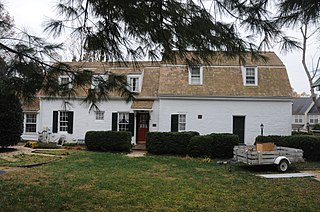
Howard's Inheritance is a historic home near Annapolis, Anne Arundel County, Maryland, United States. It is a 1 1⁄2-story gambrel-roofed brick house with a hall-parlor plan. The building appears to have been constructed as early as 1760, with interior finishes renewed about 1840. Also on the property is a 19th-century frame corn crib.

Rich Mountain is a historic home and farm complex located at Frederick, Frederick County, Maryland, United States. It is on the remaining 10-acre (40,000 m2) tract from the original farm. The complex consists of a stone dwelling dating from 1810–1820 with a one-story kitchen wing; a 19th-century frame Pennsylvania barn; and a hog barn, wagon shed / corn crib, equipment shed, and chicken coop. The house combines Federal style elements with regional vernacular features.

Harris Farm is a historic home and farm complex located at Walkersville, Frederick County, Maryland, United States. The main house was built in 1855, and is a three-story center plan house in predominantly late Greek Revival syle, with some Italianate elements. The agricultural complex consists of a bank barn with an attached granary; a second frame barn that shares an animal yard with the bank barn; a row of frame outbuildings including a converted garage, a workshop, and a chicken house. There is also a drive-through double corn crib; and a frame pig pen from 1914. The 20th-century buildings consist of a frame poultry house, a dairy barn with milk house and two silos, and an octagonal chicken coop. A lime kiln is located on the edge of the property. The property is preserved as part of the Walkersville Heritage Farm Park.
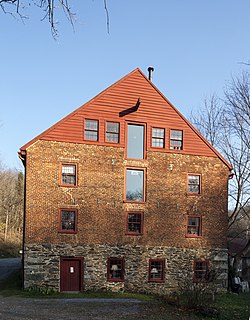
Lewis Mill Complex is a historic grist mill complex located at Jefferson, Frederick County, Maryland. The complex consists of seven standing structures, a house foundation, and the remains of an earlier millrace. It centers on an early 19th-century three-story brick mill structure with a gabled roof. The mill complex served German immigrant farmers in Middletown Valley between 1810 and the 1920s. It was rehabilitated in 1979-1980 for use as a pottery shop. Also in the complex are a stuccoed log house and log springhouse built about; a frame wagon shed and corn crib structure and frame barn dating from the late 19th century; and early 20th century cattle shelter and a frame garage.

Hills, Dales and The Vinyard is a historic home located at Keedysville, Washington County, Maryland, United States. It is a two-story late 18th century log house, with an early 19th-century stone addition. The property also includes stone retaining walls, stone fences, a stone bank barn foundation, and a late 19th-century timber framed corn crib.

Kefauver Place is a historic farm complex located at Rohrersville, Washington County, Maryland, United States. It includes a log cabin built about 1820; a log barn of about 1830 with later-19th-century additions; a 19th-century timber-framed corn crib; a two-story brick house constructed around 1880; an early-20th-century masonry root cellar; and a frame summer kitchen, hog pen, chicken house, and garage all dating from about 1930. Also on the property are two fieldstone spring enclosures. It is located on a 21-acre (85,000 m2) property.

The Wye Town Farm House is a historic home in Easton, Talbot County, Maryland, United States. It is of brick construction, one and one-half stories high and two rooms deep with a small one-story brick kitchen. A two-story addition was made in the 20th century. The original section of the house dates from about 1800.

Old Bloomfield is a historic home at Easton, Talbot County, Maryland, United States. It is a large and sprawling structure constructed in three major sections: a 1 1⁄2-story, three bay brick section with a steeply pitched roof built about 1720; a 1 1⁄2-story frame addition on the southwest gable built about 1840; and a 2-story frame wing on the southwest end of this earlier addition. Also on the property is a small frame dairy, a heavy timber-frame crib, and a barn. It has remained in the same family as a working farm continuously since the 17th century.
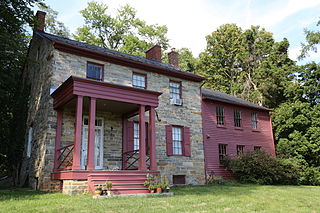
Woodside is a historic home located at Abingdon, Harford County, Maryland. It has a 2 1⁄2-story main section, designed in 1823, that is an excellent example of a Federal side hall, double parlor plan house. The house is constructed of coursed fieldstone and ashlar. The property includes a stone house with overhanging gable roof, a hand pump, a shed-roofed frame storage building, an 1848 log barn, a 1928 frame corn crib, and three early 20th century garages.
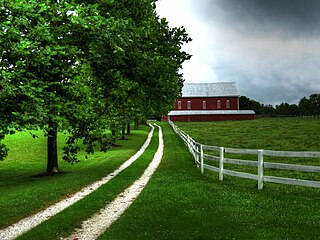
The Andrew P. Frizzell House and Farm Complex is a historic home and farm complex located at Westminster, Carroll County, Maryland, United States.

Mt. Pleasant, also known as the Clemson Family Farm, is a historic home located at Union Bridge, Carroll County, Maryland, United States. It is a five-bay by two-bay, 2 1⁄2-story brick structure with a gable roof and built about 1815. Also on the property is a brick wash house, a hewn mortised-and-tenoned-and-pegged timber-braced frame wagon shed flanked by corn cribs, and various other sheds and outbuildings. It was the home farm of the Farquhar family, prominent Quakers of Scotch-Irish descent who were primarily responsible for the establishment of the Pipe Creek Settlement.

Jacob F. Shaffer Farm is a historic home and farm complex located at Millers, Carroll County, Maryland. The complex consists of a brick house built in 1854, a rare stone bank barn, a frame summer kitchen, and a frame corn crib. The house is a two-story, three-bay wide, banked Federal / Greek Revival style brick structure with Flemish bond on the east-facing facade.

Rockland Farm is a historic home and farm complex located at Westminster, Carroll County, Maryland, United States. The complex consists of a brick house, the stone foundation of an 18th-century springhouse, as well as a large frame barn and a corn crib, both dating to the late 19th century. The house, built in 1795, retains the Pennsylvania German traditional three-room plan with a central chimney. It is a two-story, three-bay by two-bay brick structure on a stone foundation built into a slope.
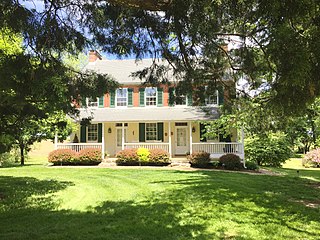
The Christian Royer House is a historic home located at Westminster, Carroll County, Maryland, United States. It was built about 1828, and served dual functions as a farmhouse and a Church of the Brethren meeting house. The house is two stories of brick, with a five-bay by two-bay main section and a three-bay long central rear wing. The rear wing features a double-tiered inset porch on both sides in the two bays adjoining the main section of the house. Also on the property are a late 19th-century corn crib and a large 20th-century barn. The features distinguishing this as a meeting house are the double entrance on the main facade, the folding wood-panel partition walls that open to provide single large space and the extensive kitchen facilities.

The Catalpa Farm is a historic home and farm complex located at Princess Anne, Somerset County, Maryland, United States. It is a two-story, five-bay center passage structure built in two principal stages. The older section is a two-story, three-bay side-hall parlor house with service wing erected around 1825–1840. A two-story one-room plan frame addition was attached shortly thereafter. Also on the property are an early 19th-century dairy and smokehouse, a late 19th-century privy, a modern garage, a mid-19th-century corn crib, an early 20th-century gambrel-roofed barn, and an early 19th-century tobacco house.




















